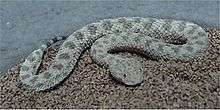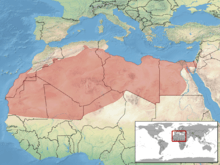Cerastes vipera
| Cerastes vipera | |
|---|---|
 | |
| Scientific classification | |
| Kingdom: | Animalia |
| Phylum: | Chordata |
| Subphylum: | Vertebrata |
| Class: | Reptilia |
| Order: | Squamata |
| Suborder: | Serpentes |
| Family: | Viperidae |
| Subfamily: | Viperinae |
| Genus: | Cerastes |
| Species: | C. vipera |
| Binomial name | |
| Cerastes vipera (Linnaeus, 1758) | |
 | |
| Synonyms | |
| |
Cerastes vipera is a venomous viper species endemic to the deserts of North Africa and the Sinai Peninsula. No subspecies are currently recognized.[4]
Description

Adults average 20–35 cm (8-14 inches) in total length (body + tail), with a maximum total length of 50 cm (1.6 ft). Females are larger than males.[3] Small and stout, it has a broad, triangular head with small eyes set well forward and situated on the junction of the side and the top of the head.
Common names
Common names include Sahara sand viper, Avicenna viper,[3] common sand viper,[5] Egyptian asp, Cleopatra's asp, sand viper,[6] Avicenna's sand viper, lesser cerastes.[7]
Geographic range
It is found in arid North Africa: Mauritania, Morocco, Algeria, Mali, Tunisia, Libya, Niger, Chad and Egypt. Sinai Peninsula: Egypt and Israel.
The type locality given is "Ægypto" (Egypt).[2]
See also
- List of viperine species and subspecies
- Viperinae by common name
- Viperinae by taxonomic synonyms
- Snakebite
References
- ↑ http://www.iucnredlist.org/details/178210/0
- 1 2 McDiarmid RW, Campbell JA, Touré T. 1999. Snake Species of the World: A Taxonomic and Geographic Reference, Volume 1. Herpetologists' League. 511 pp. ISBN 1-893777-00-6 (series). ISBN 1-893777-01-4 (volume).
- 1 2 3 Mallow D, Ludwig D, Nilson G. 2003. True Vipers: Natural History and Toxinology of Old World Vipers. Malabar, Florida: Krieger Publishing Company. 359 pp. ISBN 0-89464-877-2.
- ↑ "Cerastes vipera". Integrated Taxonomic Information System. Retrieved 30 July 2006.
- ↑ Gotch AF. 1986. Reptiles — Their Latin Names Explained. Poole, UK: Blandford Press. 176 pp. ISBN 0-7137-1704-1.
- ↑ Brown JH. 1973. Toxicology and Pharmacology of Venoms from Poisonous Snakes. Springfield, Illinois: Charles C. Thomas. 184 pp. LCCCN 73-229. ISBN 0-398-02808-7.
- ↑ U.S. Navy. 1991. Poisonous Snakes of the World. United States Government Publication. New York: Dover Publications Inc. 203 pp. ISBN 0-486-26629-X.
Further reading
- Boulenger GA. 1896. Catalogue of the Snakes in the British Museum (Natural History). Volume III., Containing the...Viperidæ. London: Trustees of the British Museum (Natural History). (Taylor and Francis, printers). xiv + 727 pp. + Plates I.- XXV. (Cerastes vipera, pp. 503–504).
- Joger, Uhlrich. 1984. The Venomous Snakes of the Near and Middle East. Beihefte zum Tübinger Atlas des Vorderen Orients, A, 12. Wiesbaden: Dr. Ludwig Reichert Verlag. 115 pp. ISBN 3882261994.
- Linnaeus C. 1758. Systema naturæ per regna tria naturæ, secundum classes, ordines, genera, species, cum characteribus, diferentiis, synonymis, locis. Tomus I. Editio Decima, Reformata. Stockholm: L. Salvius. 824 pp. (Coluber vipera, p. 216).
- Schnurrenberger, Hans. 1959. Observations on Behavior in Two Libyan Species of Viperine Snakes. Herpetologica 15 (2): 70-72. (Aspis vipera).
- Subach, A, Scharf, I & Ovadia, O. 2009. Foraging behavior and predation success of the sand viper (Cerastes vipera). Canadian Journal of Zoology 87: 520-528. PDF
External links
| Wikimedia Commons has media related to Cerastes vipera. |
- Cerastes vipera at the Reptarium.cz Reptile Database. Accessed 2 August 2007.
